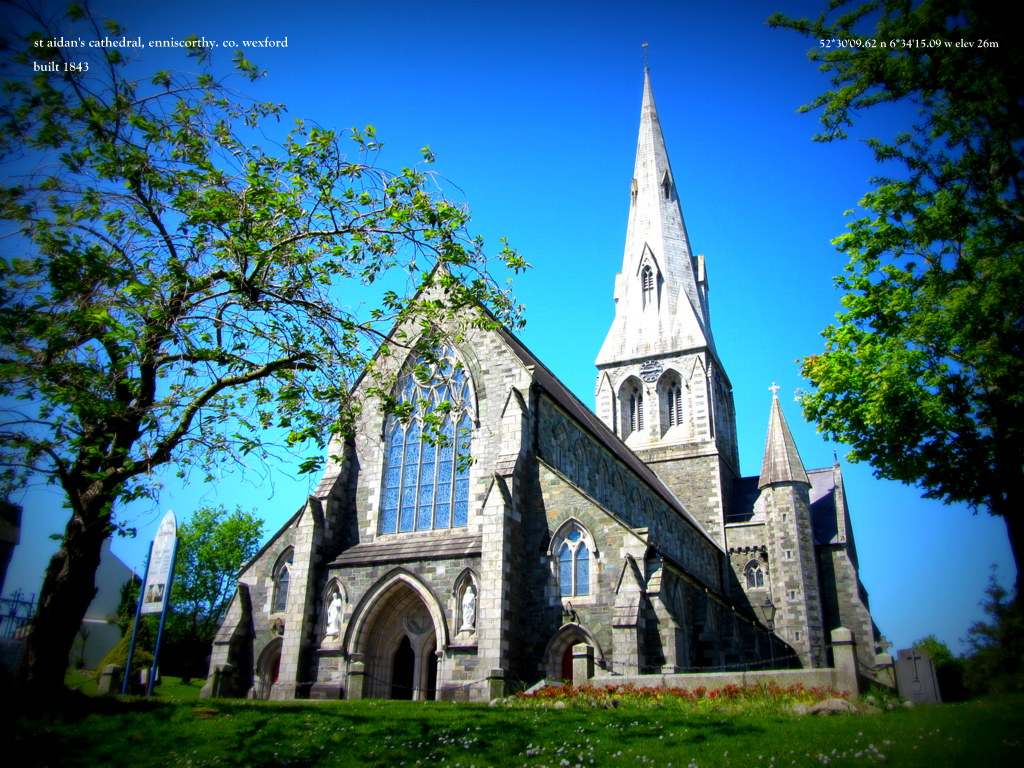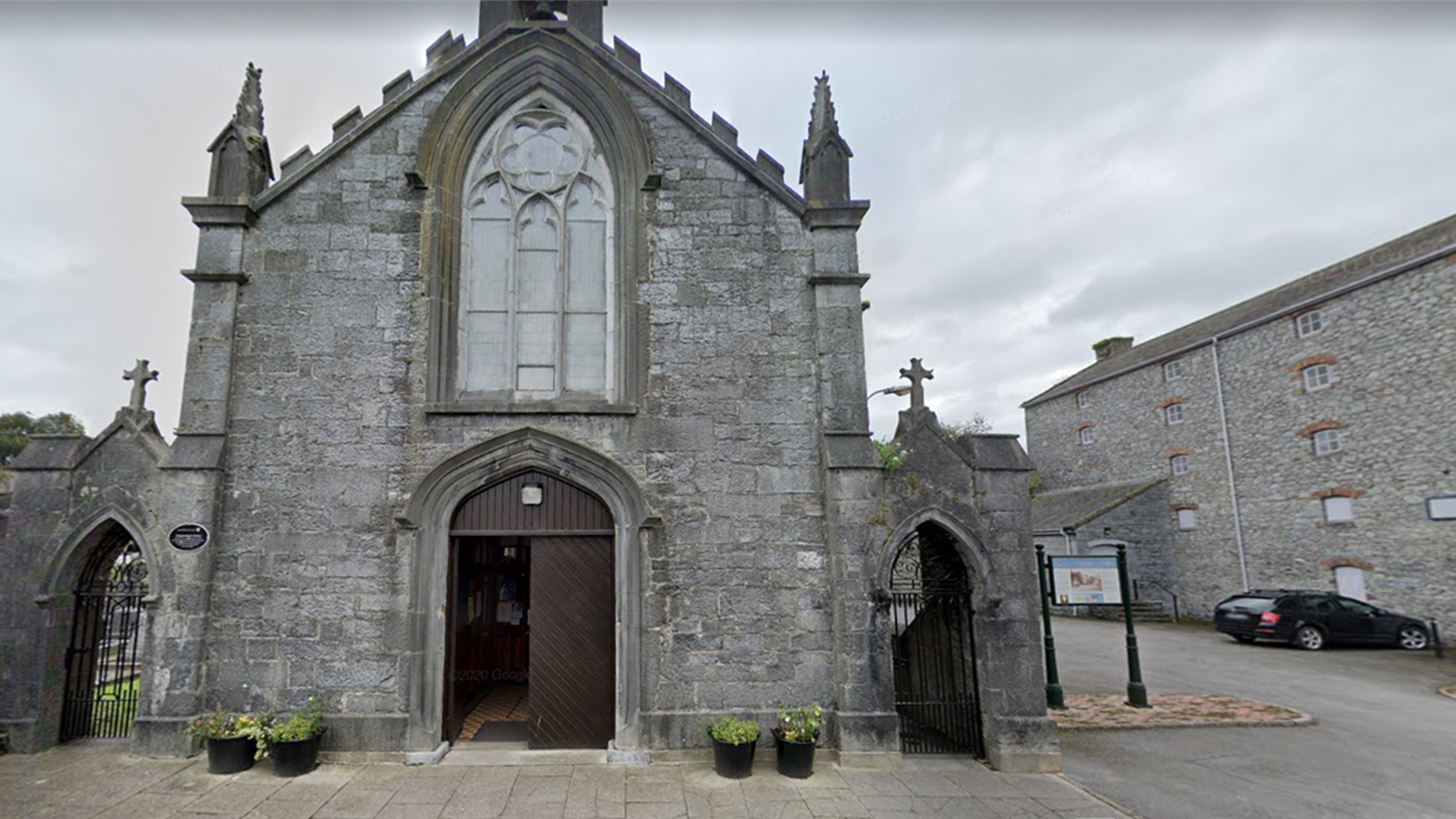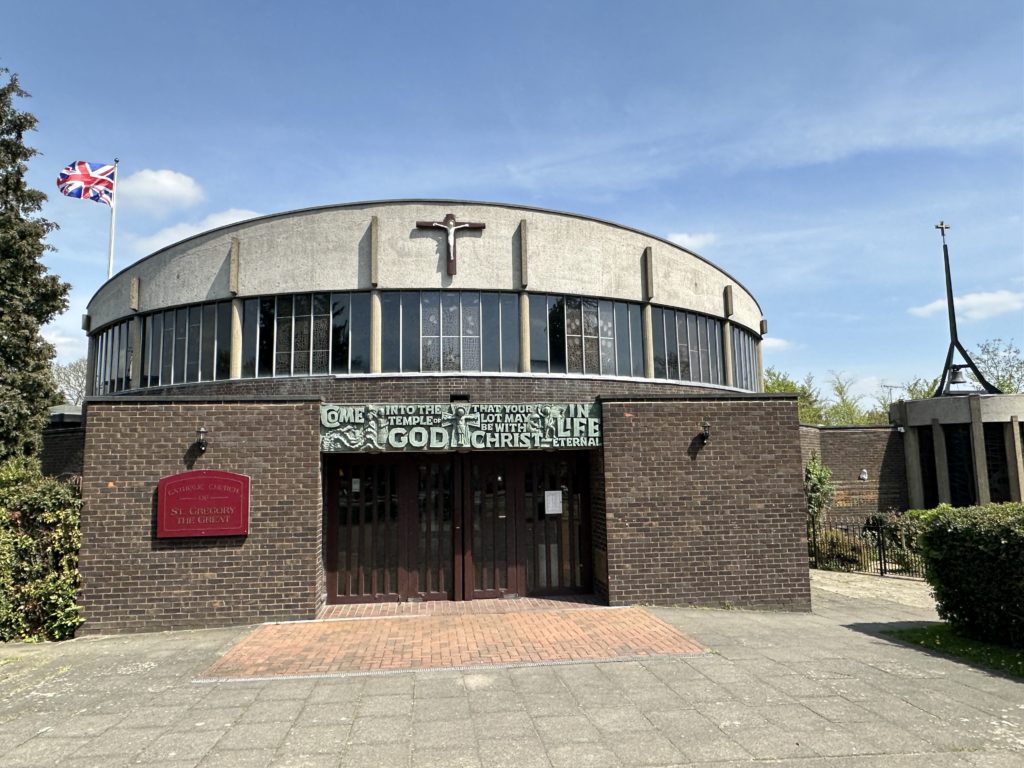Churches of the Day
Pictorial Thought for Today
Jul 11 - St Benedict (480-547), abbot, Patron of Europe
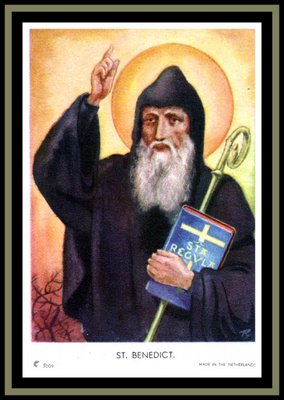 St Benedict, founder of Western monasticism and author of the Rule which gave monasticism its constitution, exercised a fundamental influence on the development of European civilisation and culture. Because of this, in 1964, Pope Paul VI named him patron saint of Europe.
St Benedict, founder of Western monasticism and author of the Rule which gave monasticism its constitution, exercised a fundamental influence on the development of European civilisation and culture. Because of this, in 1964, Pope Paul VI named him patron saint of Europe.Patrick Duffy tells his story.
Early Life
St. Benedict was born, a twin with St Scholastica, into a wealthy family at Nursia in east-central Umbria around the year 480. He went to school in Rome but, disturbed by the moral laxity of other students in Rome, he left before completing his studies. Seeking peace and quiet he withdrew to Subiaco situated in the mountains about forty miles from Rome. Here he met a monk called Romanus who helped him in his first steps as a hermit.
Overcoming Temptations
At Subiaco Benedict spent three years in a cave where he "underwent the three fundamental temptations that all human beings face: self-affirmation and the desire to place oneself at the centre, ... sensuality, ... and anger and revenge" (Pope Benedict XVI). Only by overcoming these temptations would he be able find the right words to give others in their situations of need.
First Monastery at Subiaco
Soon disciples joined him and he became the leader of a monastic community at Subiaco. Some monks there were unhappy with Benedict's strict discipline and put poison in his wine. When they brought it to Benedict to drink, he blessed it and the glass miraculously broke. "God forgive you," he exclaimed, and he went off again to the wilderness.
Maur and Placidus
More monks came to Subiaco and Benedict had twelve small monasteries with twelve in each one in that area. Some Roman senators came and left their sons with Benedict for education. Some of these turned out to be his most faithful disciples, St Maur and St Placid. The story of Maur rescuing Placid from drowning in the lake of Subiaco is told in Gregory, Dialogues II,7 and in artworks and mosaics. Placid was for some centuries regarded as the patron of Benedictine novices. Others, including a local priest, became envious and spread slander about Benedict.
Second Foundation at Monte Cassino
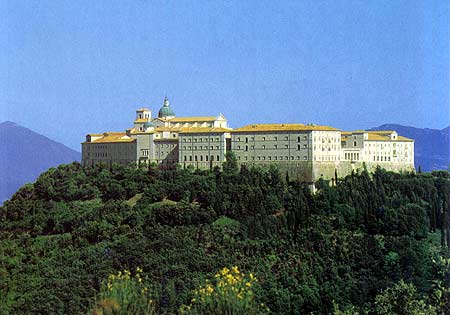 Around 529 Benedict left Subiaco for Monte Cassino, where he built a great abbey and lived till his death in 547. Scholars, like Mabillon and Muratori, have argued from ancient pictures and inscriptions that Benedict was a deacon, but not a priest. From St Gregory's account of his life in the Dialogues, it is clear that he preached in the neighbouring areas and that he was generous to the needy.
Around 529 Benedict left Subiaco for Monte Cassino, where he built a great abbey and lived till his death in 547. Scholars, like Mabillon and Muratori, have argued from ancient pictures and inscriptions that Benedict was a deacon, but not a priest. From St Gregory's account of his life in the Dialogues, it is clear that he preached in the neighbouring areas and that he was generous to the needy.
Significance of Monte Cassino
Pope Benedict XVI recently described the decision of his namesake St Benedict to locate his monastery on Monte Cassino as symbolic. Monte Cassino is, he said, "a height that dominates the surrounding plains and is visible from a distance". "Monastic life," the Pope continued, "has its raison d'etre in withdrawal and concealment, but a monastery also has a public role in the life of the Church and of society".
Benedictine Monasteries in Ireland
Glenstal Abbey in Co Limerick (www.glenstal.org/) and Holy Cross Monastery, Rostrevor, Co. Down (www.benedictinemonks.co.uk), are two Benedictine monasteries in Ireland which strive to fulfil this ideal.
Benedict's Twin Sister
 Scholastica became the first Benedictine nun and set up a nunnery at Plombaria, about five miles from Monte Cassino. Brother and sister used to meet once a year at a house some distance from his monastery. On his last visit Scholastica, sensing perhaps that the end was near for both of them, asked him to stay longer 'to discuss the joys of heaven'. When he declined, she prayed God would come to her help. Almost immediately a storm blew up. Benedict and his fellow monks could not leave. Benedict said, "God forgive you, sister. What have you done?" She replied, "I asked a favour of you and you refused. I asked God and he has granted it." They spent the night as she had wished. Three days later she died. Benedict himself seems to have died quite soon after that.
Scholastica became the first Benedictine nun and set up a nunnery at Plombaria, about five miles from Monte Cassino. Brother and sister used to meet once a year at a house some distance from his monastery. On his last visit Scholastica, sensing perhaps that the end was near for both of them, asked him to stay longer 'to discuss the joys of heaven'. When he declined, she prayed God would come to her help. Almost immediately a storm blew up. Benedict and his fellow monks could not leave. Benedict said, "God forgive you, sister. What have you done?" She replied, "I asked a favour of you and you refused. I asked God and he has granted it." They spent the night as she had wished. Three days later she died. Benedict himself seems to have died quite soon after that.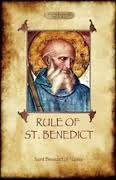 The Rule of St Benedict
The Rule of St BenedictThe Rule of St Benedict is a book of 73 chapters describing the organisation of the life of monks living in community and striving by means of the common life, ascetic practice, prayer and work to experience a life of fellowship with God. Its tone and tenor can be summed up in the motto of the Benedictine Confederation PAX ("peace") and the traditional adage ORA ET LABORA ("pray and work"). Benedict had a deep personal love of Jesus and his rule is Rule is wise, humane, tolerant and moderate. It stresses humility before God and each other. Its richness is that it fosters an understanding of the relational nature of human beings on their individual journeys to God. It provides for a spiritual father to support individual ascetic effort and spiritual growth.
Prayer and Love
Benedict seems to have lived his life immersed in an atmosphere of prayer and it was this prayer that made him alive to the concrete needs of his neighbours.
____________________________
******************************
Memorable Sayings for Today
Listen with the ear of your heart
~ St Benedict ~
"The devil is afraid of us when we pray and make sacrifices.
He is also afraid when we are humble and good.
He is especially afraid when we love Jesus very much.
He runs away when we make the Sign of the Cross
~ St Anthony, Abbot of the Desert~
******************************
St Benedict, Abbot, Patron of Europe
11-07 St Benedict, hermit at Subiaco, founded the monastery of Monte Cassino. As abbot, he wrote his wise rule for the Benedictines and Cistercians, and was later named Patron of Europe d. 547
C/f A short life of this saint can be found below todays' Readings and Reflection.
FIRST READING
A reading from the Book of Proverbs 2:1-9
Apply your heart to truth.
My son, you take my words to heart, if you set store by my commandments, tuning your ear to wisdom, and applying your heart to truth:
Yes, if your plea is for clear perception,
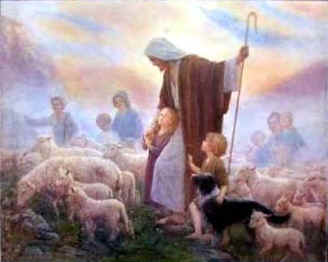 if you cry out for discernment, if you look for it as if it were silver,
if you cry out for discernment, if you look for it as if it were silver,and search for it as for buried treasure, you will then understand what the fear of the Lord is, and discover the knowledge of God.
For the Lord himself is giver of wisdom, from his mouth issue knowledge and discernment.
He keeps his help for honest men, he is the shield of those whose ways are honourable;
he stands guard over the paths of justice, he keeps watch on the way of his devoted ones.
Then you will understand what virtue is, justice, and fair dealing, all paths that lead to happiness.
The Word of the Lord. Thanks be to God
Responsorial Psalm Ps 33: 2-11, R/v 2
Response I will bless the Lord at all times.
Or Taste and see that the Lord is good.
1. I will bless the Lord at all times, his praise always on my lips;
in the Lord my soul shall make its boast. The humble shall hear and be glad. Response
2. Glorify the Lord with me. Together let us praise his name.
I sought the Lord and he answered me; from all my terrors he set me free. Response
3. Look towards him and be radiant; let your faces not be abashed.
This poor man called; the Lord heard him and rescued him from all his distress. Response
4. The angel of the Lord is encamped around those who revere him, to rescue them.
Taste and see that the Lord is good. He is happy who seeks refuge in him. Response
5. Revere the Lord, you his saints. They lack nothing, those who revere him.
Strong lions suffer want and go hungry but those who seek the Lord lack no blessing. Response
Gospel Acclamation Mt 5: 3
Alleluia, alleluia!
How happy are the poor in spirit; theirs is the kingdom of heaven.
Alleluia!
GOSPEL
The Lord be with you And with your spirit.
A reading from the holy Gospel according to Matthew 19:27-29 Glory to you, O Lord
Everyone who has followed me will be repaid a hundred times over.
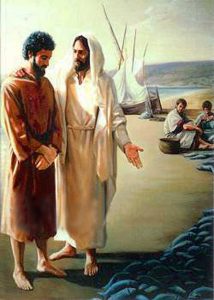
Peter spoke to Jesus. 'What about us?' he said 'We have left everything and followed you. What are we to have, then?'
Jesus said to him, 'I tell you solemnly, when all is made new and the Son of Man sits on his throne of glory, you will yourselves sit on twelve thrones to judge the twelve tribes of Israel.
And everyone who has left houses, brothers, sisters, father, mother, children or land for the sake of my name will be repaid a hundred times over, and also inherit eternal life. Many who are first will be last, and the last, first.'
The Gospel of the Lord. Praise to you, Lord Jesus Christ.
________________________________________________________
Gospel Reflection 11th July, St Benedict, abbot, Patron of Europe, Matthew 19:27-29
‘The first monks in Italy and Gaul followed Eastern models and rules, which were usually marked by extreme austerity. It was Saint Benedict who adapted monasticism to European needs, and laid the foundations of the great monastic system which bears his name. Benedict was born in Norcia in Italy about the year 480, and as a youth studied in Rome. Disliking the licentiousness of the city, and feeling that he had a special call from God, he retired to a cave at Subiaco, about forty miles south of Rome. He lived there for three years. His manner of life attracted followers, and this led to the establishment of a monastery at Subiaco, which still exists. Later, probably in 528 or 529, he went further south and built the great abbey of Monte Cassino in the central Apennines.
He remained there until his death in 547, and it is there that he drew up his famous Rule for Monks’ (Website of Mount St Joseph’s Abbey, Roscrea, Co. Tipperary, Ireland). Saint Benedict taught his monks the value of the common life. They would often pray alone, but they would also pray and work together and show hospitality to visitors. Having left their families and home, the monks discovered a new family, the community of their brother monks and of the wider world. In response to Peter’s question in the gospel reading, ‘What about us? We have left everything to follow you. What are we to have then?’
Jesus promises his disciples that everyone who has left home and family for his sake will be repaid a hundred times over. Most of us are not called to leave home and family for Jesus’ sake. Yet, there is always something we have to leave or let go of if we are to remain the Lord’s faithful followers. Jesus assures us that if we are prepared to take this path of letting go for his sake, we will always receive more from him than we have let go.
__________________________________
The Scripture Readings are taken from The Jerusalem Bible, published 1966 by Darton, Longman & Todd Ltd. and used with the permission of the publishers. http://dltbooks.com/
The Scripture Reflection is made available with our thanks from his book Reflections on the Weekday Readings : The Word is near to you, on your lips and in your heart by Martin Hogan and published by Messenger Publications , c/f www.messenger.ie/bookshop/
________________________________________________
Saint of the Day: July 11, St Benedict, abbot, Patron of Europe
Summary, St Benedict: Born at Nursia (Umbria, Italy) about 480; died at Monte Cassino about 547. After studies in Rome he became a hermit at Subiaco, where many sought his counsel, and later founded the monastery at Monte Cassino. Noted for his widely influential monastic rule, combining work and prayer, and for his charity and moderation.
 St Benedict, founder of Western monasticism and author of the Rule which gave monasticism its constitution, exercised a fundamental influence on the development of European civilisation and culture. Because of this, in 1964, Pope Paul VI named him patron saint of Europe.
St Benedict, founder of Western monasticism and author of the Rule which gave monasticism its constitution, exercised a fundamental influence on the development of European civilisation and culture. Because of this, in 1964, Pope Paul VI named him patron saint of Europe.Patrick Duffy tells his story.
Early Life
St. Benedict was born, a twin with St Scholastica, into a wealthy family at Nursia in east-central Umbria around the year 480. He went to school in Rome but, disturbed by the moral laxity of other students in Rome, he left before completing his studies. Seeking peace and quiet he withdrew to Subiaco situated in the mountains about forty miles from Rome. Here he met a monk called Romanus who helped him in his first steps as a hermit.
Overcoming Temptations
At Subiaco Benedict spent three years in a cave where he "underwent the three fundamental temptations that all human beings face: self-affirmation and the desire to place oneself at the centre, ... sensuality, ... anger/ revenge" (Pope St Benedict XVI). Only by overcoming these temptations would he be able find the right words to give others in their situations of need.
First Monastery at Subiaco
Soon disciples joined him and he became the leader of a monastic community at Subiaco. Some monks there were unhappy with Benedict's strict discipline and put poison in his wine. When they brought it to Benedict to drink, he blessed it and the glass miraculously broke. "God forgive you," he exclaimed, and he went off again to the wilderness.
Ss Maur and Placidus
More monks came to Subiaco and Benedict had twelve small monasteries with twelve in each one in that area. Some Roman senators came and left their sons with Benedict for education. Some of these turned out to be his most faithful disciples, St Maur and St Placid. The story of Maur rescuing Placid from drowning in the lake of Subiaco is told in Gregory, Dialogues II,7 and in artworks and mosaics. Placid was for some centuries regarded as the patron of Benedictine novices. Others, including a local priest, became envious and spread slander about Benedict.
Second Foundation at Monte Cassino
 Around 529 Benedict left Subiaco for Monte Cassino, where he built a great abbey and lived till his death in 547. Scholars, like Mabillon and Muratori, have argued from ancient pictures and inscriptions that Benedict was a deacon, but not a priest. From St Gregory's account of his life in the Dialogues, it is clear that he preached in the neighbouring areas and that he was generous to the needy.
Around 529 Benedict left Subiaco for Monte Cassino, where he built a great abbey and lived till his death in 547. Scholars, like Mabillon and Muratori, have argued from ancient pictures and inscriptions that Benedict was a deacon, but not a priest. From St Gregory's account of his life in the Dialogues, it is clear that he preached in the neighbouring areas and that he was generous to the needy.
Significance of Monte Cassino
Pope Benedict XVI recently described the decision of his namesake St Benedict to locate his monastery on Monte Cassino as symbolic. Monte Cassino is, he said, "a height that dominates the surrounding plains and is visible from a distance". "Monastic life," the Pope continued, "has its raison d'etre in withdrawal and concealment, but a monastery also has a public role in the life of the Church and of society".
Benedictine Monasteries in Ireland
Glenstal Abbey in Co Limerick (www.glenstal.org/) and Holy Cross Monastery, Rostrevor, Co. Down (www.benedictinemonks.co.uk), are two Benedictine monasteries in Ireland which strive to fulfil this ideal.
Benedict's Twin Sister
 Scholastica became the first Benedictine nun and set up a nunnery at Plombaria, about five miles from Monte Cassino. Brother and sister used to meet once a year at a house some distance from his monastery. On his last visit Scholastica, sensing perhaps that the end was near for both of them, asked him to stay longer 'to discuss the joys of heaven'. When he declined, she prayed God would come to her help. Almost immediately a storm blew up. Benedict and his fellow monks could not leave. Benedict said, "God forgive you, sister. What have you done?" She replied, "I asked a favour of you and you refused. I asked God and he has granted it." They spent the night as she had wished. Three days later she died. Benedict himself seems to have died quite soon after that.
Scholastica became the first Benedictine nun and set up a nunnery at Plombaria, about five miles from Monte Cassino. Brother and sister used to meet once a year at a house some distance from his monastery. On his last visit Scholastica, sensing perhaps that the end was near for both of them, asked him to stay longer 'to discuss the joys of heaven'. When he declined, she prayed God would come to her help. Almost immediately a storm blew up. Benedict and his fellow monks could not leave. Benedict said, "God forgive you, sister. What have you done?" She replied, "I asked a favour of you and you refused. I asked God and he has granted it." They spent the night as she had wished. Three days later she died. Benedict himself seems to have died quite soon after that. The Rule of St Benedict
The Rule of St BenedictThe Rule of St Benedict is a book of 73 chapters describing the organisation of the life of monks living in community and striving by means of the common life, ascetic practice, prayer and work to experience a life of fellowship with God. Its tone and tenor can be summed up in the motto of the Benedictine Confederation PAX ("peace") and the traditional adage ORA ET LABORA ("pray and work"). Benedict had a deep personal love of Jesus and his rule is Rule is wise, humane, tolerant and moderate. It stresses humility before God and each other. Its richness is that it fosters an understanding of the relational nature of human beings on their individual journeys to God. It provides for a spiritual father to support individual ascetic effort and spiritual growth.
Prayer and Love
Benedict seems to have lived his life immersed in an atmosphere of prayer and it was this prayer that made him alive to the concrete needs of his neighbours.
____________________________
******************************
Memorable Sayings for Today
Listen with the ear of your heart
~ St Benedict ~
"The devil is afraid of us when we pray and make sacrifices.
He is also afraid when we are humble and good.
He is especially afraid when we love Jesus very much.
He runs away when we make the Sign of the Cross
~ St Anthony, Abbot of the Desert~
******************************
Sliocht as an céad Leabhar Seanfhocail 2:1-9
Claon do chroí chun na tuisceana.
A mhic, má ghlacann tú le mo bhriathra, má thaisceann tú m’aitheanta i do chroí,
Sa chaoi go dtugann tú cluas don eagna, agus go gclaonann tú do chroí chun na tuisceana,
Sea, má ghlaonn tú chugat an grinneolas,

má scairteann tú ar an tuiscint, Má lorgaíonn tú í mar a lorgófá airgead,
má chuardaíonn tú í mar a chuardofá stór folaithe,
Tuigfidh tú ansin cad is eagla an Tiarna ann, agus cuirfidh tú aithne ar Dhia.
Óir is é an Tiarna féin a thugann an eagna,
agus is as a bhéal a thagann an grinneolas agus an tuiscint.
Bíonn a eagna stuama in áirithe aige do na fíréin;
is sciath é don mhuintir a chaitheann a saol go macánta.
Cosnaíonn sé cosáin na córa; cumhdaíonn sé bealach na ndaoine a bhíonn dílis dó.
Tuigfidh tú ansin an fhíréantacht agus an chóir, an ceart agus bealach na fíréantachta.
Briathar an Tiarna Buíochas le Dia
Psalm le Freagra Sm 33 : 2-11, R/v 2
Freagra Beannóidh mé an Tiarna i dtólamh
Malairt Freagra Blaisigí is féachaigí a fheabhas atá an Tiarna
1. Beannóidh mé an Tiarna i dtólamh beidh a mholadh i mo bhéal i gcónaí.
Bíonn m’anam ag déanamh mórtais as an Tiarna: éistfidh daoine ísle agus beidh áthas orthu. Freagra
2. Móraigí an Tiarna mar aon liom: tugaimis adhradh dá ainm in éineacht.
Bhí mé ag lorg an Tiarna agus d’éist sé liom agus d’fhuascail sé ó m’eagla go léir mé. Freagra
3. Féachaigí chuige agus loinnir oraibh ’s na bíodh luisne na náire in bhur leicne.
Nuair a scairt an t-ainniseoir seo d’éist an Tiarna, agus shaor sé óna chúngaigh go léir é. Freagra
4. Bíonn aingeal an Tiarna i gcampa thart ar lucht a eaglaithe, á bhfuascailt.
Blaisigí is féachaigí a fheabhas atá an Tiarna: is aoibhinn dá dtagann faoina dhídean. Freagra
5. A dhaoine naofa an Tiarna, bíodh a eagla oraibh; ní bhíonn díth ar an dream lenarb eagal é.
Bíonn easpa agus ocras ar leoin óga: ní bhíonn aon easpa ar lucht iarrtha an Tiarna. Freagra
Alleluia Véarsa Mth 5: 3
Alleluia, Alleluia!
Is méanar dóibh seo atá bocht ó spiorad, óir is leo ríocht na bhflaitheas.
Alleluia!
SOISCÉAL
Go raibh an Tiarna libh. Agus le do spiorad féin
Sliocht as an Soiscéal naofa de réir Naomh Matha 19:27-29 Glóir duit, a Thiarna.
Duine ar bith a leanamar mise, gheobhaidh sé níos mó faoi chéad.
 Labhair Peadar ansin agus dúirt sé le Íosa:
Labhair Peadar ansin agus dúirt sé le Íosa:Sinne, féach, d’fhágamar an uile ní agus leanamar thusa:
cad a bheidh againn, más ea?”
Dúirt Íosa leo:
“Deirim libh go fírinneach, san athghiniúint, nuair a bheidh Mac an Duine ina shuí i ríchathaoir a ghlóire, beidh sibhse a bhí do mo leanúint in bhur suí freisin i dhá ríchathaoir déag ag tabhairt breithe ar dhá threibh déag Iosrael.
Agus duine ar bith a d’fhág tithe nó deartháireacha nó deirfiúracha, nó athair nó máthair, nó bean, nó clann, nó tailte mar gheall ar m’ainm, gheobhaidh sé níos mó faoi chéad agus an bheatha shíoraí mar oidhreacht."
Soiscéal an Tiarna. Moladh duit, a Chriost
AN BÍOBLA NAOFA
© An Sagart
Fifteenth Sunday of Ordinary Time, Year C
The Good Samaritan Sunday Gospel reminds us, appeals to us calls to us, urges us, shouts to us
to be a good Samaritan to others and ourselves for God's sake and our own, like Jesus was and is.
FIRST READING
A reading from the Book of Deuteronomy 30: 10-14
The Word is very near to you for your observance.
Moses said to the people:
'Obey the voice of the Lord your God, keeping those commandments and laws of his that are written in the Book of this Law, and you shall return to the Lord your God with all your heart and soul.

'For this Law that I enjoin on you today is not beyond your strength or beyond your reach. It is not in heaven, so that you need to wonder, "Who will go up to heaven for us and bring it down to us, so that we may hear it and keep it?"
Nor is it beyond the seas, so that you need to wonder, "Who will cross the seas for us and bring it back to us, so that we may hear it and keep it?"
No, the Word is very near to you, it is in your mouth and in your heart for your observance.'
The word of the Lord Thanks be to God.
Responsorial Psalm Ps 68
Response Seek the Lord, you who are poor, and your hearts will revive.
1. This is my prayer to you, my prayer for your favour.
In your great love, answer me, O God, with your help that never fails:
Lord, answer, for your love is kind; in your compassion, turn towards me. Response
2. As for me in my poverty and pain let your help, O God, lift me up.
I will praise God's name with a song; I will glorify him with thanksgiving. Response
3. The poor when they see it will be glad and God-seeking hearts will revive;
for the Lord listens to the needy and does not spurn his servants in their chains. Response
4. For God will bring help to Zion and rebuild the cities of Judah.
The sons of his servants shall inherit it; those who love his name shall dwell there. Response
SECOND READING
A reading from the letter of St Paul to the Colossians 1: 15-20
All things were created through Christ and for him.
Christ Jesus is the image of the unseen God and the first-born of all creation,
for in him were created all things in heaven and on earth:

everything visible and everything invisible, Thrones, Dominations, Sovereignties, Powers –
all things were created through him and for him.
Before anything was created, he existed, and he holds all things in unity.
Now the Church is his body, he is its head.
As he is the Beginning, he was first to be born from the dead, so that he should be first in every way; because God wanted all perfection to be found in him and all things to be reconciled through him and for him, everything in heaven and everything on earth,
when he made peace by his death on the cross.
The Word of the Lord Thanks be to God.
Gospel Acclamation Jn 15: 15
Alleluia, alleluia!
The sheep that belong to me listen to my voice, says the Lord, I know them and they follow me.
Alleluia!
Or Jn : 63.68
Alleluia, alleluia!
Your words are spirit and they are life: you have the message of eternal life.
Alleluia!
GOSPEL
The Lord be with you. And with your spirit
A reading from the Gospel according to Luke 10: 25-37 Glory to you, O Lord
Who is my neighbour?
There was a lawyer who, to disconcert Jesus, stood up and said to him, 'Master, what must I do to inherit eternal life?'
He said to him,'What is written in the Law? What do you read there?'
He replied,
'You must love the Lord your God with all your heart, with all your soul,
with all your strength, and with all your mind, and your neighbour as yourself'.
'You have answered right,' said Jesus 'do this and life is yours.'
But the man was anxious to justify himself and said to Jesus, 'And who is my neighbour?'
Jesus replied,
 'A man was once on his way down from Jerusalem to Jericho and fell into the hands of brigands; they took all he had, beat him and then made off, leaving him half dead. Now a priest happened to be travelling down the same road, but when he saw the man, he passed by on the other side. In the same way a Levite who came to the place saw him, and passed by on the other side.
'A man was once on his way down from Jerusalem to Jericho and fell into the hands of brigands; they took all he had, beat him and then made off, leaving him half dead. Now a priest happened to be travelling down the same road, but when he saw the man, he passed by on the other side. In the same way a Levite who came to the place saw him, and passed by on the other side.But a Samaritan traveller who came upon him was moved with compassion when he saw him. He went up and bandaged his wounds, pouring oil and wine on them. He then lifted him on to his own mount, carried him to the inn and looked after him. Next day, he took out two denarii and handed them to the innkeeper.
"Look after him," he said "and on my way back I will make good any extra expense you have."
Which of these three, do you think, proved himself a neighbour to the man who fell into the brigands` hands?' 'The one who took pity on him' he replied.
Jesus said to him, 'Go, and do the same yourself.'
The Gospel of the Lord Praise to you, Lord Jesus Christ
*******************************
For homily resources for this Sunday's Gospel click here: https://www.catholicireland.net/sunday-homily/
Taken from THE JERUSALEM BIBLE, published and copyright 1966 by Darton, Longman and Todd Ltd and Doubleday, a division of Random House Inc, and used by permission of the publishers.
Sliocht as LeabharDeotranaimí 30:10-14
Tá an briathar an-ghar duit le comhlíonadh.
 Dúirt Maois lesi an bpobal:
Dúirt Maois lesi an bpobal:má ghéilleann tú do ghlór an Tiarna do Dhia agus a aitheanta a choimeád agus na reachtanna leis atá scríofa sa leabhar seo a dhlí, agus má chasann tú chun an Tiarna do Dhia ó do chroí go hiomlán agus ó d’anam go hiomlán.
'Óir an dlí seo a aithním duit inniu níl sé thar do chumas ná gan breith agat air. Ní ar neamh atá sé agus nár mhór duit a rá:
‘Cé rachaidh suas ar neamh dúinn lena bhreith anuas chugainn, chun go gcluinfimís é agus déanamh dá réir?”
Ní mó ná sin is thar lear atá agus nár mhór duit a rá:
‘Cé rachaidh thar lear dúinn agus é a thabhairt chugainn chun go gcluinfimís é agus déanamh dá réir?”
Ní amhlaidh atá; tá an briathar an-ghar duit; tá sé i do bhéal agus i do chroí agat le comhlíonadh.'
Briathar an Tiarna Buíochas le Dia
Salm le Freagra Sm 68
Freagra Cuardaigh an Tiarna, a dhaoine ísle, agus athbheofar bhur gcroí
1. Chugatsa a chuirim m'urnaí, a Thiarna, an uair is mian leat féin.
Éist liom de réir do bhuanghrá agus do chúnaimh chinnte.
Freagair mé as ucht do dhilghrá, a Thiarna; iompaigh chugam de réir do thrócaire. Freagra
2. Maidir liomsa, nuair is daibhir dobrónach mé, tógadh do chúnamh mé, a Dhia.
Molfaidh mé ainm Dé le hamhrán; déanfaidh mé é a mhóradh le haltú buíochais. Freagra
3. Beidh áthas ar na hísle nuair a fheicfidh siad é; athbheofar croíthe lucht cuardaithe an Tiarna.
Éisteann an Tiarna leis na daoine bochta, is ní thugann droim láimhe da bhraighdeanaigh. Freagra
4. Óir déanfaidh Dia Síón a shaoradhagus atógfaidh sé cathracha Iúda.
Beidh siad ina n-oidhreacht ag sliocht a sheir bhíseach, ag an muintir a thugann grá dá ainm. Freagra
DARA LÉACHT
Sliocht as céad Litir Naomh Pól chuig na Colosaigh 1:15-20
Is trí an Chríost a cruthaíodh an t-iomlán.
Is íomhá den Dia dofheicthe an Chríost agus céadghin gach dúile cruthaithe mar is trídsean a cruthaíodh
 a bhfuil ar neamh agus ar talamh
a bhfuil ar neamh agus ar talamhbídís sofheicthe nó dofheicthe, idir Thróin agus Thiarnais
idir Phrionsachtaí agus Chumhachtaí. Is trídsean agus dósan a cruthaíodh an t-iomlán.
Tá tosach aige orthu uile agus is ann a choinnítear ar bun iad.
Is é ceann an choirp é, ceann na hEaglaise.
Is é an tús é, an chéadghin ó mhairbh i dtreo go mbeadh an tosach aige ar gach slí.
Mar is ann ab áil le lánmhaireacht iomlán Dé a bheith ina cónaí,
agus is trídsean ab áil leis gach a bhfuil ar neamh agus ar talamh
a thabhairt chun athmhuintearais leis féin.
Briathar an Tiarna Buíochas le Dia
Alleluia Véarsa Eo 10: 27
Alleluia, alleluia!
Éisteann mo chaoirigh le mo ghlór,a deir the Tiarna agus aithním iad, agus leanann siad mé.
Alleluia!
Comhgháir an tSoiscéil Eo 6: 63, 68
Alleluia, alleluia!
Na focail atá ráite agat, a Thiarna, is spiorad agus is beatha iad. Is agatsa atá briathra na beatha síora.í
Alleluia!
SOISCÉAL
Go raibh an Tiarna libh. Agus le do spiorad féin
Sliocht as Soiscéal naofa de réir Naomh Lúcás 10:25-37 Glóir duit, a Thiarna.
Agus cé hé mo chomharsa?
San am sin d’éirigh dlíodóir ina sheasamh agus dúirt leis, á phromhadh:
“A Mháistir, cad tá le déanamh agam chun go mbeinn páirteach sa bheatha shíoraí?”
Dúirt sé leis: “Cad tá scríofa sa dlí? Cad a léann tú ann?”
D’fhreagair sé agus dúirt:
“‘Gráóidh tú do Thiarna Dia ó do chroí go hiomlán agus ó d’anam go hiomlán agus ó do neart go hiomlán agus ó d’aigne go hiomlán’; agus ‘do chomharsa mar thú féin.’”
Dúirt sé leis: “Thug tú an freagra ceart: déan an méid sin agus beidh an bheatha agat.”
Ach ó b’áil leis seo a cheart a phlé, dúirt sé le Íosa: “Agus cé hé mo chomharsa?”
Thug Íosa freagra air á rá:
 “Bhí fear ag dul síos ó Iarúsailéim go hIreachó, agus tharla i measc robálaithe é a rinne é lomadh agus é leadradh agus é a fhágáil ina ndiaidh leathmharbh. Ach le halt na haon uaire, bhí sagart ag dul síos an bóthar sin, agus ar a fheiceáil dó, ghabh sé don taobh thall thairis. Mar an gcéanna do Léivíteach: ar theacht chun na háite agus ar a fheiceáil dó, ghabh sé don taobh thall thairis.
“Bhí fear ag dul síos ó Iarúsailéim go hIreachó, agus tharla i measc robálaithe é a rinne é lomadh agus é leadradh agus é a fhágáil ina ndiaidh leathmharbh. Ach le halt na haon uaire, bhí sagart ag dul síos an bóthar sin, agus ar a fheiceáil dó, ghabh sé don taobh thall thairis. Mar an gcéanna do Léivíteach: ar theacht chun na háite agus ar a fheiceáil dó, ghabh sé don taobh thall thairis.Ach, Samárach a bhí ag gabháil an bóthar, tháinig sé mar a raibh sé, agus ar a fheiceáil dó, ghabh trua é, agus chuaigh sé anonn chuige agus chuir ceangal ar a chréachta, tar éis dó ola agus fíon a dhoirteadh iontu; chuir sé ar mhuin a bheithígh féin é, sheol go teach ósta é, agus rinne cúram de. Agus lá arna mhárach, thóg sé amach dhá dhéanar agus thug don óstóir iad agus dúirt: ‘Déan cúram de, agus cibé méid a chaithfidh tú thairis sin, íocfaidh mé leat é ag filleadh dom.’
Cé acu den triúr sin, do bharúil, ba chomharsa don té a tharla i líon na robálaithe?”
Dúirt sé: “An té a rinne an trócaire air.”
Dúirt Íosa leis: “Imigh leat, agus déan féin mar an gcéanna.”
Soiscéal an Tiarna. Moladh duit, a Chriost
AN BÍOBLA NAOFA
© An Sagart


